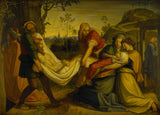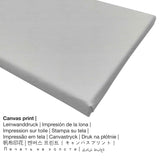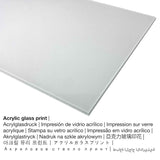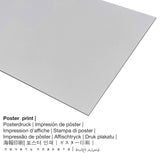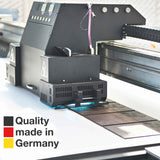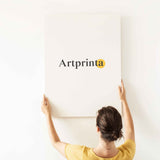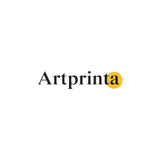Peter Cornelius, 1825 - The Entombment of Christ - fine art print
Tax included. Shipping calculated at checkout.
Summary of this over 190 year-old artwork
The modern art artpiece The Entombment of Christ was made by the artist Peter Cornelius. The 190 years old version of the piece of art was painted with the size 34,0 x 47,1 cm. Oil on wood was used by the European painter as the technique for the piece of art. Today, the artpiece is included in the Thorvaldsens Museum's collection, which is a single-artist museum dedicated to the art of Danish neoclassicistic sculptor Bertel Thorvaldsen. With courtesy of - Peter Cornelius, The Entombment of Christ, 1825, Thorvaldsens Museum, www.thorvaldsensmuseum.dk (public domain).Creditline of the artwork: . On top of that, alignment of the digital reproduction is in landscape format with a ratio of 1.4 : 1, meaning that the length is 40% longer than the width. The painter Peter Cornelius was a European artist, whose artistic style was mainly Romanticism. The German painter was born in the year 1783 in Düsseldorf, Northrhine-Westfalia, Germany and deceased at the age of 84 in the year 1867.
Your product material options
For every art print we offer a range of different materials & sizes. Therefore, we allow you to choose among the following options:
- The canvas print: A printed canvas, which shall not be confused with a canvas painting, is a digital image printed on an industrial printer. It produces the exclusive look of three dimensionality. A canvas print of your favorite artpiece will allow you to transform your into a large size collection piece like you know from art galleries. The great advantage of canvas prints is that they are relatively low in weight. This means, it is quite simple to hang up your Canvas print without the support of any wall-mounts. Canvas prints are suitable for all types of walls.
- Metal print (aluminium dibond): These are metal prints on aluminium dibond material with a true depth - for a modern impression and a non-reflective surface. A direct Aluminium Dibond Print is the best introduction to fine art replicas manufactured on aluminum. Colors are luminous and vivid in the highest definition, the fine details of the print appear clear and crisp, and you can notice the matte appearance. This direct print on Aluminum Dibond is the most popular entry-level product and is a sophisticated way to display fine art reproductions, because it draws attention on the whole artwork.
- Poster print on canvas material: The Artprinta poster is a UV printed sheet of canvas paper with a slight texture on the surface. Please note, that depending on the absolute size of the poster print we add a white margin of approximately 2 - 6cm round about the artwork, which facilitates the framing with your custom frame.
- Acrylic glass print (with real glass coating): A glossy acrylic glass print, which is often described as a plexiglass print, will change the original into amazing décor and makes a great alternative to canvas and dibond art prints. The work of art will be custom-made with modern UV print machines. The major benefit of an acrylic glass fine art copy is that contrasts plus details will be more visible thanks to the very fine tonal gradation.
Disclaimer: We try everythig possible to depict the products as clearly as possible and to exhibit them visually. Still, some pigments of the printed materials, as well as the print result can differ to a certain extent from the presentation on the device's screen. Depending on the settings of your screen and the nature of the surface, colors might not be printed 100% realistically. Bearing in mind that all are processed and printed manually, there might as well be minor differences in the exact position and the size of the motif.
About this item
| Print categorization: | wall art |
| Reproduction: | digital reproduction |
| Production process: | UV direct print (digital printing) |
| Product Origin: | made in Germany |
| Type of stock: | on demand |
| Intended product usage: | art print gallery, wall art |
| Artwork orientation: | landscape alignment |
| Image aspect ratio: | 1.4 : 1 length to width |
| Side ratio meaning: | the length is 40% longer than the width |
| Available material variants: | metal print (aluminium dibond), acrylic glass print (with real glass coating), poster print (canvas paper), canvas print |
| Canvas print (canvas on stretcher frame) size variants: | 70x50cm - 28x20", 140x100cm - 55x39" |
| Acrylic glass print (with real glass coating) size options: | 70x50cm - 28x20", 140x100cm - 55x39" |
| Poster print (canvas paper) options: | 70x50cm - 28x20" |
| Dibond print (alumnium material) size variants: | 70x50cm - 28x20", 140x100cm - 55x39" |
| Frame: | not available |
Background data about the artwork
| Title of the piece of art: | "The Entombment of Christ" |
| Classification of the artwork: | painting |
| Umbrella term: | modern art |
| Century: | 19th century |
| Artpiece year: | 1825 |
| Approximate age of artwork: | more than 190 years old |
| Original medium of artwork: | oil on wood |
| Dimensions of the original artwork: | 34,0 x 47,1 cm |
| Exhibited in: | Thorvaldsens Museum |
| Location of the museum: | Copenhagen, Denmark |
| web page: | Thorvaldsens Museum |
| License: | public domain |
| Courtesy of: | Peter Cornelius, The Entombment of Christ, 1825, Thorvaldsens Museum, www.thorvaldsensmuseum.dk |
Artist information
| Name: | Peter Cornelius |
| Other names: | Peter von Cornelius, Cornelius Peter |
| Artist gender: | male |
| Artist nationality: | German |
| Jobs: | painter |
| Country of origin: | Germany |
| Artist classification: | modern artist |
| Styles: | Romanticism |
| Age at death: | 84 years |
| Born: | 1783 |
| Birthplace: | Düsseldorf, Northrhine-Westfalia, Germany |
| Year of death: | 1867 |
| City of death: | Berlin, Berlin state, Germany |
© Copyright protection - Artprinta.com
Original artwork description by the museum's website (© Copyright - Thorvaldsens Museum - www.thorvaldsensmuseum.dk)
The picture is a recreation of Raphael’s The Deposition from 1507 in the Galleria Borghese at Rome. Raphael was considered the greatest artist of all time, but Cornelius, who arrived in Rome in 1811 and joined Overbeck and the Nazarenes, was nevertheless aware that even the art of the incomparable Raphael did not perhaps in every respect live up to the demand for piety that had applied in the Middle Ages and which the Nazarenes were working to re-establish. Whereas Raphael’s version is characterised by almost heroic action, Cornelius allows a simple, quiet sorrow to descend on his scene. Cornelius was born at Düsseldorf and left Rome in 1819 because he had been appointed Director of the Academy of Fine Arts in his native city. At the same time he was given the commission by Ludwig of Bavaria to decorate the Glyptotek at Munich, and in 1824 he was appointed Director of the Academy there. His importance for German painting in the 19th century was enormous.

